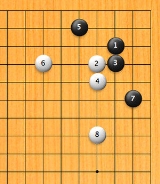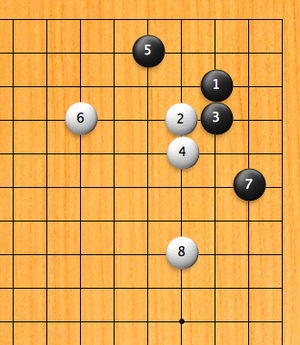
Joseki
Encyclopedia

Go (board game)
Go , is an ancient board game for two players that originated in China more than 2,000 years ago...
, are studied sequences of moves in the corner areas of the Go board, for which the result is considered balanced for both black and white sides. Because games typically start with plays in the corners
Go opening theory
In the game of Go, the term opening theory refers to concepts which underlie where, why, in what order, and in what shapes the first several moves are played...
, players often try to use their understanding of joseki to gain local advantages in the corners — advantages which can in turn make for a better overall position. Though less common, there are also joseki for the middle game. In Japanese
Japanese language
is a language spoken by over 130 million people in Japan and in Japanese emigrant communities. It is a member of the Japonic language family, which has a number of proposed relationships with other languages, none of which has gained wide acceptance among historical linguists .Japanese is an...
, 定 (jō) means "fixed" or "set" and 石 (seki) means stones, giving the literal meaning "set stones", as in "set pattern". In Chinese
Chinese language
The Chinese language is a language or language family consisting of varieties which are mutually intelligible to varying degrees. Originally the indigenous languages spoken by the Han Chinese in China, it forms one of the branches of Sino-Tibetan family of languages...
, the term for joseki is 定式, dìngshì.
The concept of "balance" here often refers to an equitable trade-off between securing territory in the corner versus making good thickness toward the sides and center. In application these concepts are in fact very dynamic, and often joseki are deviated from depending on the needs of the situation, and the opportunities available. While learning joseki is a tool to defend against a local loss, players always seek to take advantage of weaknesses in the opponent's shapes
Shape (Go)
In the game of Go, shape describes the positional qualities of a group of stones. Descriptions of shapes in go revolve around how well a group creates or removes life and territory. Good shape can refer to the efficient use of stones in outlining territory, the strength of a group in a prospective...
, often deviating from the joseki.
Using joseki
The current body of joseki are not fixed, but patterns that have gained acceptance in professional games. That is, they form a consensus judgement that might change in the future, or with certain caveats. Hence the basic definition may be misleading for new players in that joseki can be misconstrued as foolproof and unalterable, and are otherwise optimal for all situations. Many joseki are in fact useful only for study within an artificially confined corner, and in real play are only considered good form when used in proper combination with other plays on the board (i.e. other joseki and fuseki moves).Knowing a particular joseki simply means that one knows a sequence of moves, resulting in a balance or fair trade-off between their positions. This is in practice much easier than appraising how joseki relate to the rest of the board—hence knowledge of joseki is regarded as shallow, when compared with the ability to integrate a strategy into a complex game landscape.
There is a go proverb
Go proverb
Go proverbs are traditional proverbs relating to the game of Go, generally used to help one find good moves in various situations during a game. They are generalisations and thus a particular proverb will have specific situations where it is not applicable. Knowing when a proverb is inapplicable is...
that states that "learning joseki loses two stones in strength," meaning that rote learning
Rote learning
Rote learning is a learning technique which focuses on memorization. The major practice involved in rote learning is learning by repetition by which students commit information to memory in a highly structured way. The idea is that one will be able to quickly recall the meaning of the material the...
of sequences is not advantageous. Rather learning from joseki should be a player's goal. Hence the study of joseki is regarded as a double-edged sword and useful only if learned (not by rote) by understanding the principles behind each move. Every joseki should be used as a specific tool that leaves the board in a particular shape.
Just as using an improper tool in machinery can be devastating, choosing the wrong joseki can easily be worse than improvising one's own moves. In his book A Way of Play for the 21st Century, Go Seigen
Go Seigen
Wu Qingyuan , generally known in the West by his Japanese name Go Seigen, is considered by many players to be the greatest player of the game of Go in the 20th century and of all time.-Biography:...
compared choosing the proper joseki to choosing the proper medicine: Pick the right one, and you feel better. Pick the wrong one, and you die.(par.
Paraphrase
Paraphrase is restatement of a text or passages, using other words. The term "paraphrase" derives via the Latin "paraphrasis" from the Greek , meaning "additional manner of expression". The act of paraphrasing is also called "paraphrasis."...
) Rui Naiwei
Rui Naiwei
Rui Naiwei is a Chinese professional Go player, now active in South Korea...
similarly remarked that playing joseki is easy [but] choosing the right one [in a game] is hard.(par.)
A joseki may fall out of use for various reasons, some of which may often seem minor to the amateur player, and professionals may consider one variation suboptimal for a very specific reason —one which strong amateurs are not likely to exploit.
There is no definitive guide to what is joseki; the situation with joseki dictionaries is similar to that of natural language dictionaries, in that some entries are obsolete and the listing is not likely to be complete.
While some claim that studying joseki is an important part of developing one's strength
Go ranks and ratings
Skill in the traditional board game Go is measured by a number of different national, regional and online ranking and rating systems. Traditionally, go rankings have been measured using a system of dan and kyu ranks...
as a player, more regard the study of life and death
Life and death
Life and death is a fundamental concept in the game of Go, where the status of a distinct group of stones is determined as either being "alive", and may remain on the board indefinitely, or "dead," where the group will be lost as "captured"...
to be more important.
Basic joseki
Corner joseki conventionally start with one player occupying a corner point, in an empty 10×10 area of the board, and the other player replying with an approach move (Japanese kakari). The initial play in the corner is almost always on a 3-3, 3-4, 3-5, 4-4 or 4-5 point. Other plays that have been experimented with include 5-5, 6-3 and 6-4, all of which sacrifice territory for influence.Of those plays, the classical 3-4 point (komoku) and more contemporary 4-4 point (hoshi
Go terms
Players of the game of Go often use jargon to describe situations on the board and surrounding the game. Such technical terms are likely to be encountered in books and articles about Go in English as well as other languages. Many of these terms have been borrowed from Japanese, mostly when no short...
) are the most used. The standard approaches are at 5-3 or 5-4 to the 3-4 point, and at 3-6/6-3 to the 4-4 point. The number of subsequent variations is then quite large (of the order of ten reasonable plays for the next one).
| style="border: solid thin; padding: 2px;" | |
| A Go game opening with two common Joseki in the upper-right and lower-left. |
Also useful is the tenuki
Tenuki
is a Japanese go term also commonly used among Western players. It describes ignoring a local sequence on the board in order to play elsewhere. The maneuver is related to the concepts of sente, or taking the initiative, and gote, deferring to the opponent by responding to the last play...
concept of breaking away from a sequence, to play elsewhere, before the 'official' endpoint of the joseki. After a joseki sequence has ended, a play returning to the same area may be termed a follow-up play. There is no formal theory for these, though numerous set sequences can be seen in professional play.
It is imperative that players should not play joseki merely from rote memorization but adapt according to the overall board situation. It's important to keep in mind that go is a game involving marginal analysis and joseki are merely heuristics of sound play. Playing joseki blindly will not improve one's game.

